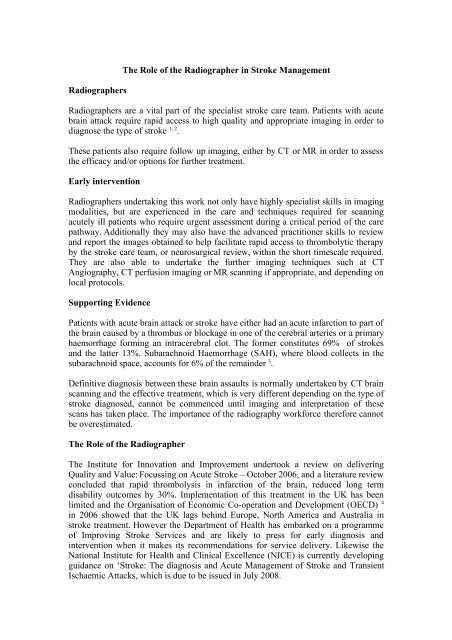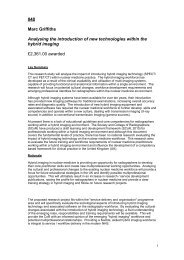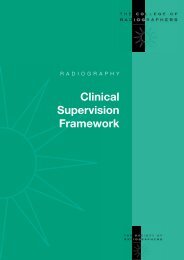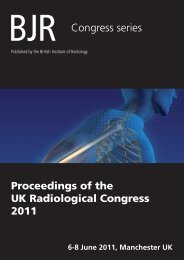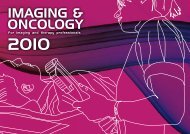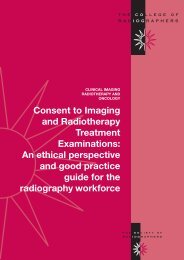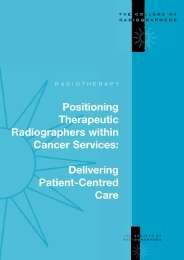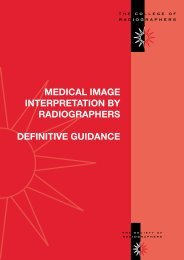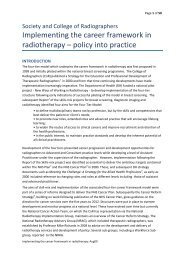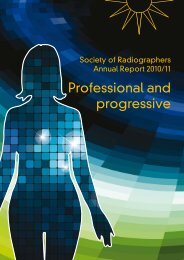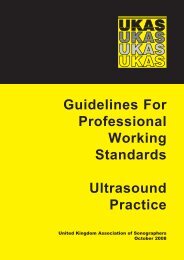The Role of the Radiographer in Stroke Management - Society of ...
The Role of the Radiographer in Stroke Management - Society of ...
The Role of the Radiographer in Stroke Management - Society of ...
Create successful ePaper yourself
Turn your PDF publications into a flip-book with our unique Google optimized e-Paper software.
<strong>Radiographer</strong>s<strong>The</strong> <strong>Role</strong> <strong>of</strong> <strong>the</strong> <strong>Radiographer</strong> <strong>in</strong> <strong>Stroke</strong> <strong>Management</strong><strong>Radiographer</strong>s are a vital part <strong>of</strong> <strong>the</strong> specialist stroke care team. Patients with acutebra<strong>in</strong> attack require rapid access to high quality and appropriate imag<strong>in</strong>g <strong>in</strong> order todiagnose <strong>the</strong> type <strong>of</strong> stroke 1, 2 .<strong>The</strong>se patients also require follow up imag<strong>in</strong>g, ei<strong>the</strong>r by CT or MR <strong>in</strong> order to assess<strong>the</strong> efficacy and/or options for fur<strong>the</strong>r treatment.Early <strong>in</strong>tervention<strong>Radiographer</strong>s undertak<strong>in</strong>g this work not only have highly specialist skills <strong>in</strong> imag<strong>in</strong>gmodalities, but are experienced <strong>in</strong> <strong>the</strong> care and techniques required for scann<strong>in</strong>gacutely ill patients who require urgent assessment dur<strong>in</strong>g a critical period <strong>of</strong> <strong>the</strong> carepathway. Additionally <strong>the</strong>y may also have <strong>the</strong> advanced practitioner skills to reviewand report <strong>the</strong> images obta<strong>in</strong>ed to help facilitate rapid access to thrombolytic <strong>the</strong>rapyby <strong>the</strong> stroke care team, or neurosurgical review, with<strong>in</strong> <strong>the</strong> short timescale required.<strong>The</strong>y are also able to undertake <strong>the</strong> fur<strong>the</strong>r imag<strong>in</strong>g techniques such at CTAngiography, CT perfusion imag<strong>in</strong>g or MR scann<strong>in</strong>g if appropriate, and depend<strong>in</strong>g onlocal protocols.Support<strong>in</strong>g EvidencePatients with acute bra<strong>in</strong> attack or stroke have ei<strong>the</strong>r had an acute <strong>in</strong>farction to part <strong>of</strong><strong>the</strong> bra<strong>in</strong> caused by a thrombus or blockage <strong>in</strong> one <strong>of</strong> <strong>the</strong> cerebral arteries or a primaryhaemorrhage form<strong>in</strong>g an <strong>in</strong>tracerebral clot. <strong>The</strong> former constitutes 69% <strong>of</strong> strokesand <strong>the</strong> latter 13%. Subarachnoid Haemorrhage (SAH), where blood collects <strong>in</strong> <strong>the</strong>subarachnoid space, accounts for 6% <strong>of</strong> <strong>the</strong> rema<strong>in</strong>der 3 .Def<strong>in</strong>itive diagnosis between <strong>the</strong>se bra<strong>in</strong> assaults is normally undertaken by CT bra<strong>in</strong>scann<strong>in</strong>g and <strong>the</strong> effective treatment, which is very different depend<strong>in</strong>g on <strong>the</strong> type <strong>of</strong>stroke diagnosed, cannot be commenced until imag<strong>in</strong>g and <strong>in</strong>terpretation <strong>of</strong> <strong>the</strong>sescans has taken place. <strong>The</strong> importance <strong>of</strong> <strong>the</strong> radiography workforce <strong>the</strong>refore cannotbe overestimated.<strong>The</strong> <strong>Role</strong> <strong>of</strong> <strong>the</strong> <strong>Radiographer</strong><strong>The</strong> Institute for Innovation and Improvement undertook a review on deliver<strong>in</strong>gQuality and Value: Focuss<strong>in</strong>g on Acute <strong>Stroke</strong> – October 2006, and a literature reviewconcluded that rapid thrombolysis <strong>in</strong> <strong>in</strong>farction <strong>of</strong> <strong>the</strong> bra<strong>in</strong>, reduced long termdisability outcomes by 30%. Implementation <strong>of</strong> this treatment <strong>in</strong> <strong>the</strong> UK has beenlimited and <strong>the</strong> Organisation <strong>of</strong> Economic Co-operation and Development (OECD) 4<strong>in</strong> 2006 showed that <strong>the</strong> UK lags beh<strong>in</strong>d Europe, North America and Australia <strong>in</strong>stroke treatment. However <strong>the</strong> Department <strong>of</strong> Health has embarked on a programme<strong>of</strong> Improv<strong>in</strong>g <strong>Stroke</strong> Services and are likely to press for early diagnosis and<strong>in</strong>tervention when it makes its recommendations for service delivery. Likewise <strong>the</strong>National Institute for Health and Cl<strong>in</strong>ical Excellence (NICE) is currently develop<strong>in</strong>gguidance on ‘<strong>Stroke</strong>: <strong>The</strong> diagnosis and Acute <strong>Management</strong> <strong>of</strong> <strong>Stroke</strong> and TransientIschaemic Attacks, which is due to be issued <strong>in</strong> July 2008.
Thrombolytic <strong>the</strong>rapy with recomb<strong>in</strong>ant tissue plasm<strong>in</strong>ogen activator (rt-PA) islicensed to be used with<strong>in</strong> 3 hours <strong>of</strong> acute ischaemic stroke, thus delays <strong>in</strong> neuroimag<strong>in</strong>gmust be m<strong>in</strong>imised 5 . A rigorous thrombolytic pathway with rapid access toCT scann<strong>in</strong>g and report<strong>in</strong>g will need to be <strong>in</strong>troduced. <strong>The</strong> patient will also need to beadmitted <strong>in</strong>to <strong>the</strong> care <strong>of</strong> <strong>the</strong> stroke team as part <strong>of</strong> this pathway.With<strong>in</strong> <strong>the</strong> UK <strong>the</strong>re are examples <strong>of</strong> Cl<strong>in</strong>ical Imag<strong>in</strong>g Departments operat<strong>in</strong>g systemswhich allow for rapid access to CT scann<strong>in</strong>g <strong>of</strong> patients 24 hours a day 7 days perweek under NICE guidel<strong>in</strong>es for Head Injury 6 . <strong>The</strong>se systems could be utilised for<strong>the</strong> imag<strong>in</strong>g <strong>of</strong> stroke patients. Interpretation <strong>of</strong> <strong>the</strong> images needs to be both rapid andaccurate. This may be achieved us<strong>in</strong>g a variety <strong>of</strong> options <strong>in</strong>volv<strong>in</strong>g neuroradiologists,appropriately skilled stroke physicians or <strong>the</strong> use <strong>of</strong> teleradiology. A more elegantsolution may be a suitably tra<strong>in</strong>ed, competent and authorised specialist radiographerto provide both imag<strong>in</strong>g and report<strong>in</strong>g. It should be noted that Postgraduate courses <strong>in</strong><strong>in</strong>terpretation <strong>of</strong> head CT images have existed for some years 7 .Imag<strong>in</strong>g overviewPatients may present to <strong>the</strong> imag<strong>in</strong>g department from a number <strong>of</strong> sources, and notnecessarily acutely. Those present<strong>in</strong>g with a Transient Ischaemic (TIA) attack mayrequire duplex carotid assessments carried out by qualified, competent and accreditedstaff, <strong>in</strong>clud<strong>in</strong>g radiographers <strong>in</strong> ei<strong>the</strong>r vascular laboratories or radiology departments.<strong>The</strong>y will quantify <strong>the</strong> stenosis and monitor progressive disease. Patients who havesuffered a stroke will also require follow up imag<strong>in</strong>g <strong>in</strong> order to ascerta<strong>in</strong> <strong>the</strong> efficacy<strong>of</strong> treatment or to quantify <strong>the</strong> extent <strong>of</strong> cerebral damage. This may take <strong>the</strong> form <strong>of</strong>CT, CT Angiography, CT perfusion, MRI, MRA, diffusion weighted imag<strong>in</strong>g or evenconventional angiography, with or without stent<strong>in</strong>g or coil<strong>in</strong>g and this is all part <strong>of</strong> <strong>the</strong>radiology department’s remit work<strong>in</strong>g <strong>in</strong> conjunction with <strong>the</strong> stroke team to try tooptimise patient outcome.Those patients who are ei<strong>the</strong>r unsuitable for thrombolysis <strong>the</strong>rapy, or who do not havea positive response, will need o<strong>the</strong>r types <strong>of</strong> imag<strong>in</strong>g such as chest X Rays, ei<strong>the</strong>r at<strong>the</strong> bedside or <strong>in</strong> <strong>the</strong> department. <strong>The</strong>y may also have associated pathology which haspredisposed <strong>the</strong>m to cerebral <strong>in</strong>farction such as peripheral vascular disease, or ahistory <strong>of</strong> mobility problems which requires radiological <strong>in</strong>vestigation. <strong>The</strong> RoyalCollege <strong>of</strong> Speech and Language <strong>The</strong>rapy have demonstrated <strong>the</strong> value <strong>of</strong> earlyassessment <strong>of</strong> dysphagia (swallow<strong>in</strong>g difficulties) and it has <strong>the</strong> potential to causelong term problems 8 .Video fluoroscopy can be useful <strong>in</strong> <strong>the</strong> assessment and appraisal <strong>of</strong> <strong>the</strong> damage, andthis is jo<strong>in</strong>tly undertaken by Speech and Language <strong>The</strong>rapists <strong>in</strong> conjunction with<strong>Radiographer</strong>s.<strong>Stroke</strong> survivors who suffer deficit follow<strong>in</strong>g a stroke will suffer ongo<strong>in</strong>g medicalproblems. <strong>The</strong>se may <strong>in</strong>clude pneumonia, ur<strong>in</strong>ary tract <strong>in</strong>fections, andthromboembolic events and <strong>the</strong>y may also have susta<strong>in</strong>ed o<strong>the</strong>r <strong>in</strong>juries at <strong>the</strong> time <strong>of</strong><strong>the</strong> stroke. In both cases <strong>the</strong>y will be frequent visitors to radiology departments and<strong>the</strong>y will require sensitive support, particularly if <strong>the</strong>y have cognitive impairment, <strong>in</strong>order to expla<strong>in</strong> and enable <strong>the</strong>m to co-operate with <strong>the</strong> imag<strong>in</strong>g modality.Workforce issues
With <strong>the</strong> rapid expansion <strong>of</strong> imag<strong>in</strong>g requirement and <strong>the</strong> pressures on RadiologyDepartments with <strong>the</strong> 18 week patient wait guidel<strong>in</strong>e 9 , imag<strong>in</strong>g departments havebeen challenged to f<strong>in</strong>d <strong>in</strong>novative ways <strong>of</strong> work<strong>in</strong>g. <strong>Radiographer</strong>s are a highlyskilled workforce but anecdotal evidence has shown limitations on tra<strong>in</strong><strong>in</strong>g budgetsand <strong>the</strong>re are difficulties <strong>in</strong> enabl<strong>in</strong>g staff to be released from departments <strong>in</strong> order toobta<strong>in</strong> advanced and appropriate skills. <strong>The</strong> <strong>Society</strong> and College <strong>of</strong> <strong>Radiographer</strong>sundertook a Radiology Manager Questionnaire <strong>in</strong> September 2006. This showed thata high percentage <strong>of</strong> CT and MR posts are frozen and this will seriously impact onhow radiographers can deliver <strong>the</strong> service. However, with <strong>the</strong> governmentcommitment to skill mix and with appropriate support from commissioners 10 , <strong>the</strong><strong>Society</strong> and College <strong>of</strong> <strong>Radiographer</strong>s supports <strong>the</strong> drive for improvement <strong>of</strong> strokecare and believes <strong>the</strong> pr<strong>of</strong>ession can help deliver this.1. Choksi V, Qu<strong>in</strong>t DJ, Maly-Sundgren P, Ellen Hoeffner E. Imag<strong>in</strong>g <strong>in</strong> Acute <strong>Stroke</strong>Applied Radiol 2005; 34: (2) 10-192. Rowley HA. <strong>The</strong> four Ps <strong>of</strong> Acute <strong>Stroke</strong> Imag<strong>in</strong>g: Parenchyma, Pipes, Perfusionand Penumbra. Am J Neuroradiol 2001; 22: 599-6013. Royal College <strong>of</strong> Physicians National Cl<strong>in</strong>ical guidel<strong>in</strong>es for <strong>Stroke</strong> (2 nd Edition)prepared by <strong>the</strong> Intercollegiate <strong>Stroke</strong> Work<strong>in</strong>g Party. RCP 20044 http://www.oecd.org/dataoecd/1/34/36262514.pdf (accessed 4 th Sept 2007)5. Kwan J, Hand P, Sandercock P. Improv<strong>in</strong>g <strong>the</strong> efficiency <strong>of</strong> delivery <strong>of</strong>thrombolysis for acute stroke: a systematic review Q J Med 2004; 97: 273-279.QJM vol. 97 no. 5 (c) Association <strong>of</strong> Physicians 20046. National Institute for Health and Cl<strong>in</strong>ical Excellence Head <strong>in</strong>jury: Triage,assessment, <strong>in</strong>vestigation and early management <strong>of</strong> head <strong>in</strong>jury <strong>in</strong> <strong>in</strong>fants, childrenand adults NICE Cl<strong>in</strong>ical guidel<strong>in</strong>e 4 June 2003http://guidance.nice.org.uk/CG4/niceguidance/pdf/English/download.dspx (accessed4 th Sept 2007), currently under review.7. Freeman C. <strong>The</strong> role <strong>of</strong> <strong>the</strong> radiographer <strong>in</strong> <strong>Stroke</strong> and Transient Ischaemic Attack(TIA) care and management. SCoR February 20078. Mann G, Hankey GJ, Cameron D. Swallow<strong>in</strong>g functions after stroke: prognosisand prognostic factors after 6 months. <strong>Stroke</strong> 1999; 30 (4).9. Department <strong>of</strong> Health Tackl<strong>in</strong>g Hospital Wait<strong>in</strong>g: <strong>the</strong> 18 week patient pathway.DoH May 200610. Department <strong>of</strong> Health Improv<strong>in</strong>g <strong>Stroke</strong> Services: a guide for commissioners.DoH Dec 2006


